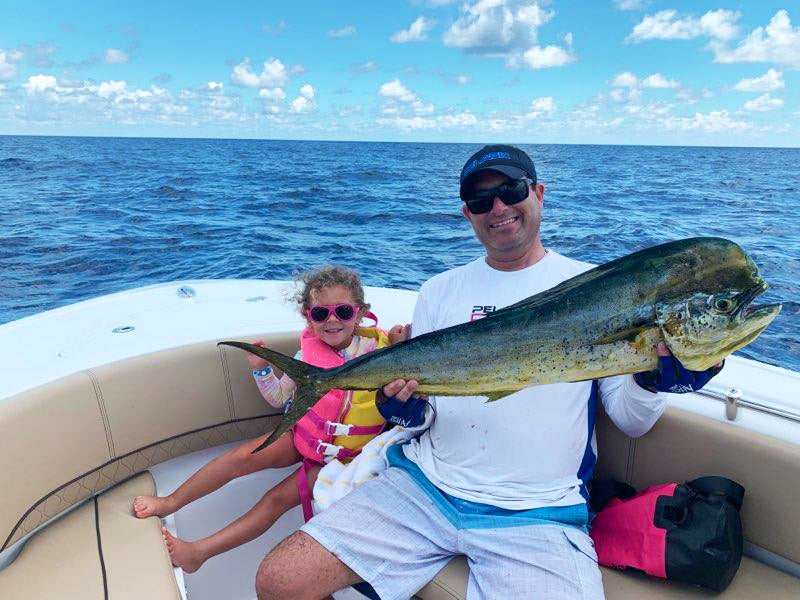By Captain Mike Franquiz, Chlophish Charters

Early one August morning in the pursuit of mahi mahi, my wife, daughter, and I began trolling our baits due east of the Boca Raton inlet in 100 feet of water. As luck would have it, we passed a local commercial fisherman who spearfishes in the area for a living. Following his lead, we felt confident that we were in a promising spot.
But, being an avid fisherman and owner of Chlophish Charters, I know firsthand that the ocean can turn off like a switch. There are days that you have the best bait, the best weather, and the cleanest water, but no matter what you do, you cannot seem to get a bite. On this day, the temperature was supposed to feel like 105 degrees by mid-day, so I knew we only had until about noon before the fish would retreat into deeper water, making them harder to locate.
Mahi mahi primarily feed on the surface, eating anything in their path—artificial lures, dead rigged ballyhoo, squid, and you name it. We trolled four lines—three on the surface and one on the planer rod (a device to hold the trolling bait 30 ft below the surface). The first hit at 6:45 am was the surface bait (wired double hook ballyhoo naked) on the right-hand side outrigger. The next second, the planer rod popped on the left side of the boat, and the reel started screaming. I was so excited thinking this could this be a doubleheader wahoo hit.
My wife Alexis knows to keep the boat straight at a slow speed to keep pressure on the fish until we get it tight to the boat for gaffing. The first fish was a big Bonita, so I knew that the other line was also likely a Bonito. Atlantic Bonita are edible and taste good if prepared properly, but we often use them for strip and chunk baits due to their oily nature and dark red meat.
Both fish were on the larger side and put up a good fight—it was an excellent early morning warm-up.
We quickly re-rigged the lines and proceeded north towards Boynton inlet. As we moved north, the water changed, and my 4-year-old daughter Chloe started getting seasick, so I had to find calmer waters. I decided to head due south and began following some sea slicks.
As we trolled south with a small 3-inch clear green hoochie squid on a No. 7 J hook in 500 feet of water, we had our four-line spread with three surface baits and one planer rod on the left outrigger side. I spotted a bird ahead of us, which is often a great sign as they notoriously give away mahi mahi feeding on the surface.
A second later, “bam,” sure enough, the rod bent over, and a fish was on. I immediately knew it a mahi mahi because I saw it jumping in the distance—they are known for their acrobatic aerial jumps, which makes catching them more exciting.

I cannot stress the importance of keeping the boat straight to maintain pressure on the lines. If given slack, a fish will likely unhook itself. We landed the fish, our first keeper of the day and had renewed hope in a successful trip.
After this catch, I had a feeling the school of mahi mahi was in the area and suspected that the bigger fish were in deeper water. So, we decided to head further offshore.
We headed southeast to 800 feet of blue water off the coast of Pompano Beach. Again, we spotted a single bird in the distance, which led us to other birds—we were in luck. We made our first pass, and two of the four rods bent over hard and started screaming.
Over the years, we’ve caught some 50-pound mahi mahi, but I was pretty sure these were around 30 pounds. Big fish like this pull a lot of line and are a workout to reel in. I finally reeled in the one right-hand side outrigger, but as soon as we went to gaff it, the fish exploded with a burst of energy, unhooked, and it was gone.
Disappointed, I immediately went to the other fish and frantically reeled until it was boat-side. Even though I knew better, I tried to gaff and reel at the same time, and just like that; another one was off the hook.
I had to give myself a moment. One minute we have the two biggest mahi mahi I have seen all year on the line, the next minute we had empty hooks and a gut-wrenching feeling of regret.
But, we aren’t ones to give up. After this disappointment, we decided to keep trying. We reeled in all of the baits, re-rigged and reset them. We then followed the birds back to the school, and before we knew it, we had two more sizeable mahi mahi on the line—this time, I was determined to land them. We decided to keep the boat straight; I would reel in the fish then hand her the rod so that she could walk to the front of the boat. With my wife holding the rod, I will gaff the fish.
My daughter watched the action—hopefully, we were planting the seeds for her love of fishing when she’s older. We gaffed the first fish, a beautiful 20 pounder and brought it over the rail. We used the same process to get the second fish into the cooler, another beautiful 20-pounder.
On a roll, we continued through the area and caught a total of five mahi mahi—what a wonderful day. Lessons relearned, but fish in our freezer.
Until next time, tight lines from Captain Mike Franquiz of Chlophish Charters in beautiful Boca Raton Florida. If you are down here and want to give it a go, give me a call—I’m happy to arrange a trip.















